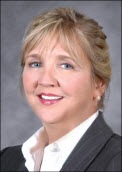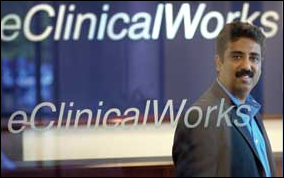EMR Vendors on HITECH – Part Two of a Series
We asked several vendor executives a series of five questions related to the economic stimulus as it impacts electronic health records.
Providers will be required to implement “certified” software to participate. Who should perform the certification and what criteria should they use?
Allscripts – Glen Tullman, CEO

We believe the Certification Commission for Healthcare Information Technology (CCHIT) is very well positioned to perform the certification of EHRs. Allscripts has been a strong supporter of CCHIT – one of the industry’s primary product certification bodies – since its inception. We are pleased that Congress appears to recognize the good work CCHIT has done through its certification process and that HHS will likely base many of its go-forward standards on that work. Today, all of the products in our EHR portfolio have current CCHIT certification, and we intend to ensure that every one of our clients is in a position to participate in the new Stimulus incentives that will become available starting in 2011.
Regarding criteria, we believe CCHIT is on the right track with its Roadmap for Expansion of Health IT Certification. We support CCHIT’s plans to include advanced interoperability, advanced quality, advanced security and advanced clinical decision support in their 2010 and 2011 certification programs. Doing so will contribute to ensuring that the widespread adoption of Electronic Health Records envisioned by President Obama results in true transformation of our healthcare system. It’s critical that physicians use EHRs that reach beyond their own practices in an interoperable fashion rather than becoming simply another “software silo.” To get there, we need to ensure that physicians and patients alike feel confident that their information will be secure. We need to ensure that certified EHRs are capable of capturing and analyzing information needed for participation in pay-for-quality programs. And we need to ensure that physicians receive real-time, accurate clinical decision support to harness the power of information.
With a certification process that measures all four of these areas – interoperability, security, quality and advanced decision support – we have a real chance to truly improve the quality and lower the cost of providing patient care in the US today.
athenahealth – Jonathan Bush, CEO, President, and Chairman

As we all know CCHIT handles this process, and we are currently in the midst of certifying for 2008 and will look to certify athenaClinicals for every single year moving forward. I am sure more and more standards and privacy entities will appear in years to come and athenahealth will incorporate whatever measures they require into our national network just the same as we do today . There will be no cumbersome version “whatever” launch and subsequent failure for athenahealth as we see with traditional software players. We release 6-8 major new versions of athenaNet a year across our entire national base over night. We also update athenaNet daily with new payor and clinical rules, security, and privacy measure etc. Today we have over 40 million various scenarios that require our proprietary rules engine in athenaNet to fire in order to guide providers away from making billing or clinical documentation errors that would lead to a poor outcome – unpaid claim or incomplete patient record. To this end, we have a website http://www.athenahealth.com/campaign/hitech/index.php , as do most HCIT vendors on the HITECH Act and issues around certified systems. However, we tried to communicate the realities of this program and attempt to give providers a moment of pause before they select the very same stagnant software systems that have proven not be adopted and utilized for many years. Certification of certain software functionally does not directly correlate with ROI or adoption. We believe providers are getting savvier to the fact they need much more flexible clinical systems that will be able to change with an evolving healthcare system and not wait hat in hand for the latest and great upgrade. I think we even saw some interesting research from Avalere Health researchers on this issue that indicated a solo or small group physician practice will spend an estimated $124,000 over the five year period of 2011-2015 to adopt and maintain a traditional EHR, and could receive up to $44,000 in federal incentive payments. The resulting financial deficit would be $70,000, or an average of $14,000 a year. The value has to come from both vendor and the incentive – software functionality is only a small part of this.
eClinicalWorks – Girish Kumar Navani, President 
Interoperability is a key objective for eClinicalWorks. Standards should focus on sharing patient records in a way that is private and secure. It is also important that technology promotes patient care, preventative measures and disease management. We would like to see standards in place that support these aspects. Whatever standards the government decides on, we are confident that we will meet them.

Eclipsys has been, and remains, a supporter of CCHIT as the proverbial Underwriters Laboratory (UL) for HCIT. We believe it is in everyone’s interest for the industry to police itself through this independent “Good Housekeeping Seal of Approval” process. Eclipsys believes that the roadmap for functionality and interoperability being laid out by CCHIT is reasonable and appropriate to create standards of certification.
eMDs – Michael Stearns MD, President and CEO

Our EHR has been certified by CCHIT in 2006, 2007 and 2008, including the child health and cardiovascular specialty certifications offered in 2008. Regardless of what direction the DHHS secretary and national coordinator decide to take, we fully commit to being compliant with any and all EHR certification requirements.

To date, CCHIT has provided the most effective and thorough certification process. The industry as a whole has invested millions into certification, interoperability, privacy and security with tremendous achievements in the last three years. Products that are currently certified with 08 CCHIT criteria have a high level of functionality that deliver long-term and interoperable solutions. CCHIT is currently the only recognized certification body (RCB) by the Secretary and by starting over; we will take considerable steps back.

The bill has language that puts the oversight of the certification process in the hands of ONCHIT. The logical assumption is that CCHIT will continue as the organization that will recommend criteria to the office of the National Coordinator, with input from the new national HIT policy and standards committees. Overall, CCHIT has done a good job in setting criteria that advance EHR functionality. I believe they should continue in this role, with oversight from ONCHIT.

We can’t say exactly who should perform the certification, and we don’t really want to. That may not be much of an issue. What the certification focuses on and requires is more relevant. Now, might the requirements demand that government oversee or take some roll in the process? Yes, they might.
The assumption seems to be that CCHIT will be the certifying body, though the organization isn’t mentioned in the legislation. Historically, CCHIT certification has not incorporated considerations such as interoperability, transparency, or affordability, which were alluded to by Congress. Maybe the requirements that come out in April will. Medsphere thinks certification must incorporate these elements. Perhaps government oversight will be required to ensure they are addressed.
What criteria should they use?
- Proven (evidence-based) to improve clinical outcomes: Medsphere’s OpenVista EHR is built on VistA, the proven and popular VA EMR system field-tested by the U.S. Department of Veterans Affairs (VA) for two decades in more than 1,300 sites of care, including 160 medical centers and 850 clinics. VistA was designed specifically for the outcomes-oriented management of patients with chronic disease, which sets it apart from most health information systems. The changes resulting from VistA at the VA are considered the largest case study ever of objectively improving care. Peer-reviewed research has documented the VA’s higher compliance with performance standards, unparalleled patient safety improvements, and better overall health outcomes than private-sector organizations resulting from its use of VistA.
- Affordable / Cost-effective: Medsphere’s OpenVista EHR leverages the multi-billion dollar public investment in the comprehensive and highly-acclaimed VistA EHR. In commercializing an already valuable tool, Medsphere has transformed VistA into OpenVista, a feature-rich EHR designed to meet the needs of acute, ambulatory, and long-term care environments as well as multi-facility, multi-specialty healthcare organizations.
- An innovative pay-as-you-go subscription pricing model enabled by open source technology incorporates no mandatory upfront implementation costs, a departure from traditional “vendor lock” solutions. Medsphere creates ongoing value via product upgrades and application support included in every subscription, helping customers get the most from their solution now and for years to come. Plus, the most a hospital is eligible for under the federal legislation is $11 million, which will easily cover OpenVista implementation. Ask Cerner or Epic if they want to do an implementation for that price.
- Interoperable: OpenVista works with existing hardware and software, thus preserving legacy IT investments. When deployed across the enterprise, the integrated platform delivers superior time-to-value and time-to-benefit. The interoperability incorporated into OpenVista also enables health information (HIE) exchange and broader coordination of patient data where other solutions simply don’t. We clearly seem to moving toward more information flowing to hospitals and clinics around the county. How is that possible if patient records are locked up in proprietary systems that won’t play nice?
- Fosters collaboration: How would healthcare progress if advances in medicine were retained by individual hospitals or research facilities? The same question is relevant with health IT. When a hospital or university develops an effective application or template, there is something unconscionable about not sharing it with other healthcare providers, particularly if it can directly and positively impact patient care. As an Open Source solution, OpenVista and our Healthcare Open Source Ecosystem encourage people to get under the hood and create. There are a hundred ways to approach a task, and only through a diversity of opinion unfettered by corporate orthodoxy can we find the best one.

As a vendor, it may not be appropriate for us to comment on who should perform the certification. But let me be clear that we support the need for the body to be well respected by all participants – including physicians. As far as the criteria needed, it probably makes sense to look towards the CCHIT 2008/2009 criteria, at least as a starting point. Various stakeholders can certainly be included in the process to make sure that all sectors are represented. It is likely that their additions, expansions, or even deletions and corrections to the CCHIT criteria should help the process gain widespread acceptance.

We think the move to NIST as the certifying body is a positive one. It is important that there be national standards that are open and fair. We also believe it is common sense for NIST to look at the CCHIT criteria as a valid starting point. We expect the NIST criteria to largely overlap with the CCHIT criteria; however we do expect NIST to be less stringent. With the amounts of monies being made available there will be a significant uptick in demand. We cannot have overly-stringent criteria eliminating supply or capacity that exists in the industry today. Also, with respect to interoperability, we think there is a great platform out there today that should continue to be leveraged…namely the Integrating the Healthcare Enterprise (IHE) Connect-a-thon. As past participants, we see this as the best available test bed to measure true data interoperability.

It makes sense that CCHIT will be the certifying body. The group has done a good job of establishing “harmony,” credibility and legitimacy among vendors, payers, providers and other 3rd parties. Additionally, there is synergy with the CMS demonstration programs since the new incentive program leveraged the CCHIT certification criteria.
However, the legislation leaves specifics unfulfilled. We will be closely monitoring developments to ensure we meet all certification requirements.

Certification requirements should be determined by a group led by the end users—that is, the busy, practicing physicians who will be using the software. The software they would structure would be easy to use, increase their productivity rather than ask them to be data entry clerks, generate reports based on the outcome measures they identify, and streamline practice workflows.
In contrast, the starting point for government EMR standards under the Stimulus Plan will likely be CCHIT. It is unfortunate that the 21-member CCHIT commission lacks significant representation by front-line, private-practice physicians. There is nothing in the certification criteria that requires that features be usable and convenient for the doctor. Of the 477 feature-focused CCHIT certification criteria for 2008, not one addresses usability. For example, it can take a doctor 20 productivity-sapping clicks to accomplish a task with a certified feature, but as long as it produces the desired result, that feature will pass certification with flying colors.
Compounding the frustration, the HITECH legislation creates a newly formed HIT Policy Committee charged with setting overall policy and overseeing the distribution of the Stimulus Plan funds. Unfortunately for front-line physicians, the committee will consist of a group of 20 politically appointed individuals with only one physician representative. This does not bode well for the development of usability-based criteria that physicians will find adoptable.
Instead of focusing on features alone, EMR developers should focus their energy and R&D budgets on producing elegant, streamlined, and efficient products that are highly usable. This has always been, and remains, the focus at SRS. Alternatives to CCHIT-type EMRs, such as hybrid EMRs, should be evaluated for their ability to boost the EMR-adoption rate.







The article about Pediatric Associates in CA has a nugget with a potentially outsized impact: the implication that VFC vaccines…